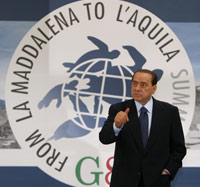G8 Summit
Major polluters water down climate commitments
Article published on the 2009-07-08 Latest update 2009-07-10 07:38 TU
The Group of Eight leading industrialized nations, meeting with China and India on the sidelines of the G8 summit, dropped a pledge to cut global emissions in half by 2050, a key target the EU had been pushing for.
“We are seeing again that we have a gap of distrust between the major industrialized countries – the US and the EU, Japan, etc – and the major emerging economies – China, India, Brazil, South Africa,” said Kim Carstensen, director of the Global Climate Change for the World Wildlife Fund, who is attending the summit.
Comment: Kim Carstensen, director of Global Climate Change for the World Wildlife Fund.
“That distrust means that the developing countries are not willing to give enough in terms of committing to their own reductions in the short term, by 2020, and not willing to give enough on finance to enable the emerging economies to say, ‘ok, now we can see that the developed countries are moving first, that they are moving strongest, and therefore we will also commit to action’”, Carstensen told RFI.
“That trust simply doesn’t exist at this time.”
Swedish Prime Minister Frederik Reinfeldt, whose nation currently holds the EU’s rotating presidency, insisted that the agreement would still contain language limiting global warming to two degrees.
Global temperatures have already risen about one degree Celsius over the last one hundred years.
Carstensen says that this clause is an attempt to cover up the failure to commit to the more ambitious - and necessary - goal of halving emissions.
“In order to get a high likelihood of actually staying below the two degrees, we need to see more action that what the developed countries have been willing to commit to so far,” he said.
“The minus 50 percent gives you a 50/50 chance of actually staying below the two degrees.”







